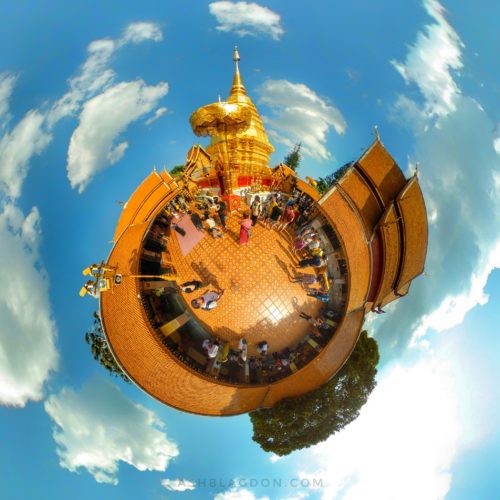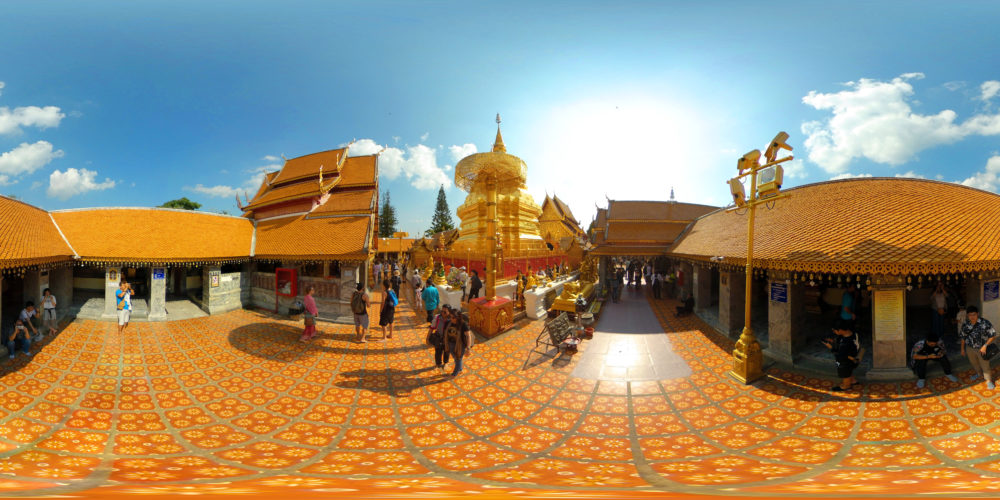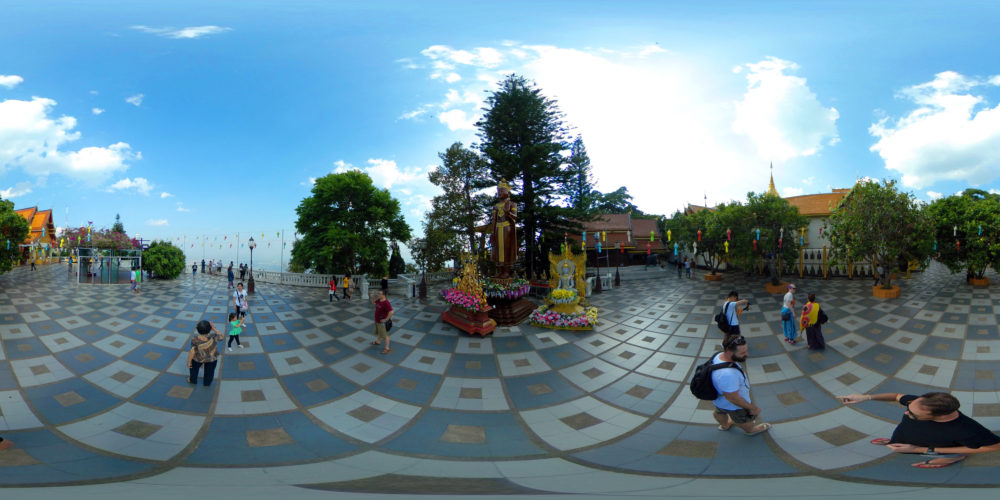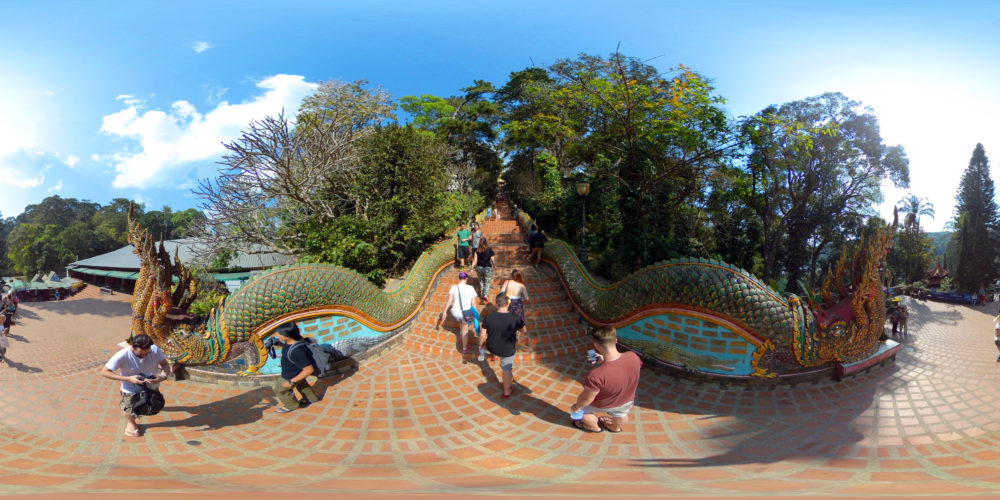High above the City is one of northern Thailand’s most sacred temples, Wat Phra That Doi Suthep and is definitely something that shouldn’t be missed. The architecture, statues, murals and shrines here are nothing short of breathtaking.
Every tuk-tuk and songthaew driver in Chiang Mai will offer to take you on the trip up the winding mountain road to Doi Suthep. When you arrive there are big red taxis everywhere, we ended up being driven up a dirt track and the driver just parked on a uneven bank where he kindly stayed and waited for us to return.
Once your at the base there are loads of shop stalls around all selling trinkets, food and water. It’s a little more expensive than you would pay in the city, but that’s to be expected. Look around and you’ll see a staircase with intricately carved mythical Naga Serpents on either side. This is the entrance to the temple, a nice casual walk up the 306 steps, though there is a lift to the right if you didn’t want to take the steps.
On reaching the top you are greeted with the sight of the golden pagoda which decorates the centre of the mountain top temple, but first you have to pay the entrance fee which is 30 THB. You’ll need to remove your shoes before entering the temple, and with the amount of people that visit its good idea to leave them in a memorable place, as no doubt it’ll be a bigger pile of shoes when you return and they’ll likely be buried.
Once inside the bright colours are quite striking especially on a sunny day as the rays hit and gleam off the golden pagoda. The architecture, statues, murals and shrines here are nothing short of breathtaking. There are a few things to see and do as you wander around. You’ll notice people walking around the centre pagoda, they do this to pay their respects by walking around 3 times in a clockwise direction while reciting words written on a laminated card which can be found on any of the four corner entrances.
We came across a fortune telling stick game (Chi Chi Sticks) where you kneel down holding a container full of numbered sticks and then you carefully shake the container until only one stick falls out on its own. To the side there is a wall with ancient Chinese prophecies written on a small pieces of paper. Each prophecy has a number, so you just match the number to that of your fallen stick. My prophecy wasn’t to bad, but there were some negative ones amongst them as one of my friends found out.
I was told it lasts for 7 days from when you’ve read it. Is that correct? Perhaps someone can correct or confirm this. We did watch a couple of ladies give it a go and they had obviously not bothered to observe others before them and they both just picked up the container, threw all the sticks on the floor and picked one up at random. They then even placed the stick in with the prophecies so no one else could pick it out. Honestly it’s not rocket science, where do these people come from?
There are several spots in the temple where you can write your name on tiles, light incense, flowers you can leave, etc. They are all self-serve, but are to be taken in exchange of a donation. Some miss the memo, but If it seems “free”, it’s donation-based. That being said, the donations asked are usually small and it all adds to the experience.
Inside the small Wiharn we found a monk sat by himself cutting and tying bits of string. These are more widely known as blessed bracelets or Sai Sin threads. You can walk over and kneel down in front of the monk. When he’s ready the monk may reach to a bowl next to him, dip a brush inside, and gently spray you with of water. He didn’t spray everyone though, for some he just holds up the string asking for an arm and ties the bracelet.
The bracelet is made of sacred white thread, it plays an important role in Buddhism and Thai culture. It has been blessed by monks for good karma and fortune. Before the Sai Sin thread is cut into smaller pieces to be used as bracelets, it partakes in a special blessing ceremony. During this ritual, the rope is wrapped around the Buddha statue, passes through the hands of the chanting monks, and even wraps around the heads and hands of those that are present to pray. As you can imagine, the original string can be quite long. After the blessing ceremony, the string is then cut into portions and eventually makes its way to people from all over. Sai Sin threads are also tied during major life events such as the celebration of a new home, marriage, or even as a gesture of goodwill from an elder.
The monk tied mine around my left wrist. It is believed that when the rope is tied into a circle, the powers of protection become stronger without a beginning or an end. Upon receiving a Sai Sin bracelet, you should keep it on for at least three days to receive the full protective powers of the thread. Many people don’t remove it and wait for it to naturally fall off. If you do want to take it off then it should be untied and stored for safekeeping instead of being cut (cutting would cut away its protective purpose). You do not have to be Buddhist to receive a Sai Sin thread– it can be thought of as a symbol of luck & compassion. Never refuse sai sin if it is offered, to do so would be disrespectful to the person offering.
Surrounding the temple is a wide walkway where you’ll find the white elephant shrine, a large viewing terrace with amazing views looking out over Chiang Mai and just past the viewing terrace is one of the worlds largest gongs, which makes an earthly rich sound when struck. Give it a try, it is allowed.
According to popular legend, the temple was built to hold a piece of bone from the Buddha’s shoulder. The bone relic was meant to have displayed magical powers and was mounted by the King Nu Naone on the back of a white elephant which was released into the jungle. The elephant is said to have climbed up Doi Suthep, at that time called Doi Aoy Chang (Sugar Elephant Mountain), stopped, trumpeted three times, then died. This was interpreted as an omen. The place where he lay is now the site of where Doi Suthep’s temple was founded.
- Built as a Buddhist monastery in 1383 it is still a working monastery today.
- The famous golden Chedi is 79 feet high and 39 feet across at its base and covered with gold plate.
- There are 306 steps flanked by naga (serpents) to reach the entrance to the temple.
- The entrance fee is 30 THB.
- Open 6am-6pm every day
Planning a trip up the mountain to see the temple is a fairly easy from Chiang Mai and there are various ways to do it. I grabbed a big red songthaew with a group of friends and the driver happily sat and waited a couple hours for us to return. It took around 25 minutes from the city centre to get there.
- You can jump in a songthaew from the city and they’ll happily sit and wait for a few hours and be ready to take you back.
- Easily accessible on a moped.
- Hiking. Want a work out? It’ll take around 1hr 30 minutes to hike up from the city.
-
Get £3 ($5) credit for your first Uber ride here.
- See a monk and receive his blessing and a Sai Sin bracelet.
- Play the fortune telling stick game, Chi Chi sticks.
- You can pay your respects to the Pagoda by walking around it 3 times in a clockwise direction while reciting the words written on laminated card.
- Check out the views from the view point.
- Strike the large gong.
- Various hiking trails
- Walk to the waterfalls and even swim.
- The entrance fee is 30 THB.
- Open 6am-6pm every day.
- Plan to spend at least a couple of hours exploring the temple and surrounding area.
- For those that do not fancy the 306 steps up to the temple, you can go up the lift and walk down the staircase when you have finished.
- Dress needs to be respectable, meaning modest and shoulders and knees should be covered.
-
Get £3 ($5) credit for your first Uber ride here.
If you found this helpful, please like and follow my social pages






























